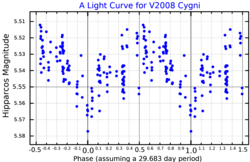 A light curve for V2008 Cygni, plotted from Hipparcos data | |
| Observation data Epoch J2000 Equinox J2000 | |
|---|---|
| Constellation | Cygnus |
| Right ascension | 20 06 21.76743 |
| Declination | +35° 58′ 20.8875″ |
| Apparent magnitude (V) | 5.38 |
| Characteristics | |
| Spectral type | G8.5 IVa |
| B−V color index | +0.85 |
| Variable type | RS CVn |
| Astrometry | |
| Radial velocity (Rv) | −32.98±0.09 km/s |
| Proper motion (μ) | RA: −225.032 mas/yr Dec.: −440.042 mas/yr |
| Parallax (π) | 41.7718 ± 0.0845 mas |
| Distance | 78.1 ± 0.2 ly (23.94 ± 0.05 pc) |
| Absolute magnitude (MV) | 3.48 |
| Details | |
| Mass | 1.26±0.03 M☉ |
| Radius | 2.51±0.05 R☉ |
| Luminosity | 4.07+0.50 −0.44 L☉ |
| Surface gravity (log g) | 3.74±0.07 cgs |
| Temperature | 5,108±26 K |
| Metallicity | −0.02±0.05 dex |
| Rotational velocity (v sin i) | 1.78±0.23 km/s |
| Age | 4.34±0.40 Gyr |
| Other designations | |
| b Cygni, 27 Cygni, V2008 Cygni, BD+35°3959, HD 191026, HIP 99031, HR 7689, SAO 69413, WDS J20064+3558A | |
| Database references | |
| SIMBAD | data |
27 Cygni is a subgiant star in the northern constellation of Cygnus. It is faintly visible to the naked eye with an apparent visual magnitude of 5.38. The distance to this system, as estimated from its annual parallax shift of 41.77 mas, is 78.1 light-years. At that distance, the visual magnitude is diminished by an extinction of 0.05 due to interstellar dust. It is moving closer to the Earth with a heliocentric radial velocity of −33 km/s, and has a relatively high proper motion, traversing the celestial sphere at the rate of 0.495″ per year.
27 Cygni is a G-type subgiant with a stellar classification of G8.5 IVa, a star that has used up its core hydrogen and is starting to expand. It was found to be slightly variable by Percy et al. (1986), changing by up to 0.05 in visual magnitude with a characteristic time scale of 50–60 days. Further observations suggested a possible rotation period of around 42 days. Samus et al. (2017) classify it as a suspected RS Canum Venaticorum variable, meaning that it is a close binary star whose components have star-spots that cause rotationally-modulated variations in brightness. It has been given the variable star designation V2008 Cygni.
27 Cygni is listed in multiple star catalogues with three faint companions within one arc-minute. The two closer ones are unrelated background objects, while the third has a similar distance and space motion and is described as a common proper motion companion.
References
- "Hipparcos Tools Interactive Data Access". Hipparcos. ESA. Retrieved 8 December 2021.
- ^ Brown, A. G. A.; et al. (Gaia collaboration) (August 2018). "Gaia Data Release 2: Summary of the contents and survey properties". Astronomy & Astrophysics. 616. A1. arXiv:1804.09365. Bibcode:2018A&A...616A...1G. doi:10.1051/0004-6361/201833051. Gaia DR2 record for this source at VizieR.
- ^ Anderson, E.; Francis, Ch. (2012), "XHIP: An extended hipparcos compilation", Astronomy Letters, 38 (5): 331, arXiv:1108.4971, Bibcode:2012AstL...38..331A, doi:10.1134/S1063773712050015, S2CID 119257644.
- ^ Keenan, Philip C.; McNeil, Raymond C. (1989), "The Perkins catalog of revised MK types for the cooler stars", Astrophysical Journal Supplement Series, 71: 245, Bibcode:1989ApJS...71..245K, doi:10.1086/191373.
- ^ Samus, N. N.; et al. (2017), "General Catalogue of Variable Stars", Astronomy Reports, 5.1, 61 (1): 80–88, Bibcode:2017ARep...61...80S, doi:10.1134/s1063772917010085, S2CID 125853869.
- ^ Jofré, E.; et al. (2015), "Stellar parameters and chemical abundances of 223 evolved stars with and without planets", Astronomy & Astrophysics, 574: A50, arXiv:1410.6422, Bibcode:2015A&A...574A..50J, doi:10.1051/0004-6361/201424474, S2CID 53666931.
- "27 Cyg". SIMBAD. Centre de données astronomiques de Strasbourg. Retrieved 2019-01-11.
- Lépine, Sébastien; Shara, Michael M. (March 2005), "A Catalog of Northern Stars with Annual Proper Motions Larger than 0.15" (LSPM-NORTH Catalog)", The Astronomical Journal, 129 (3): 1483–1522, arXiv:astro-ph/0412070, Bibcode:2005AJ....129.1483L, doi:10.1086/427854, S2CID 2603568.
- Percy, J. R.; et al. (May 1986), "Photometric Variability of 27 Cygni", Information Bulletin on Variable Stars, 2891: 1, Bibcode:1986IBVS.2891....1P.
- Evans, Nancy Remage; Percy, John R. (June 1989), "On the Variability of 27 Cygni", The Journal of the American Association of Variable Star Observers, 18 (1): 36–38, Bibcode:1989JAVSO..18...36E.
- Mason, Brian D.; Wycoff, Gary L.; Hartkopf, William I.; Douglass, Geoffrey G.; Worley, Charles E. (2001), "The 2001 US Naval Observatory Double Star CD-ROM. I. The Washington Double Star Catalog", The Astronomical Journal, 122 (6): 3466, Bibcode:2001AJ....122.3466M, doi:10.1086/323920.
- Eggleton, P. P.; Tokovinin, A. A. (September 2008), "A catalogue of multiplicity among bright stellar systems", Monthly Notices of the Royal Astronomical Society, 389 (2): 869–879, arXiv:0806.2878, Bibcode:2008MNRAS.389..869E, doi:10.1111/j.1365-2966.2008.13596.x, S2CID 14878976.